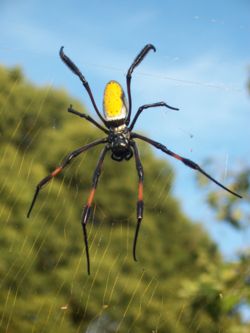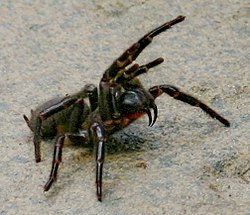Top Qs
Timeline
Chat
Perspective
Araneomorphae
Infraorder of arachnids From Wikipedia, the free encyclopedia
Remove ads
The Araneomorphae (also called the Labidognatha or "true spiders"[1]) are an infraorder of spiders. They are distinguishable by chelicerae (fangs) that point diagonally forward and cross in a pinching action, in contrast to those of Mygalomorphae (tarantulas and their close kin), which point straight down. Araneomorphs comprise the vast majority (about 93%[2]) of living spiders.
Remove ads
Distinguishing characteristics
Most spider species are Araneomorphae, which have fangs that face towards each other, increasing the orientations that they can employ during prey-capture. They have fewer book lungs (when present) – usually one pair – and the females typically live one year.
The Mygalomorphae have fangs that face towards the ground, and which are parallel to the long axis of the spider's body, thus they have only one orientation they can employ during prey capture. They have two pairs of book lungs, and the females often live many years.[3]
- This Cheiracanthium punctorium shows the orientation of Araneomorphae fangs.
- This Atrax robustus shows the orientation of Mygalomorphae fangs.
Remove ads
Spiders included
Almost all of the familiar spiders are included in the Araneomorphae group, one major exception being the tarantulas. There are a few other Mygalomorphae species that live around homes or gardens, but they typically are relatively small and not easily noticed.
The Araneomorphae, to the contrary, include the weavers of spiral webs; the cobweb spiders that live in the corners of rooms, and between windows and screens; the crab spiders that lurk on the surfaces of flowers in gardens; the jumping spiders that are visible hunting on surfaces; the wolf spiders that carpet hunting sites in sunny spots; and the large huntsman spiders.
Remove ads
Systematics
In older schemes, the Araneomorphae were divided into two lineages, the Hypochilae (containing only the family Hypochilidae), and the Neocribellatae. The Neocribellatae were in turn divided into the Austrochiloidea, and the two series Haplogynae and Entelogynae, each containing several superfamilies. Molecular phylogenetic studies have shown that the haplogynes in particular are not a monophyletic group. A 2020 study suggested the relationships among the major groups were as shown in the following cladogram.[4]
| Araneomorphae | Haplogynae | |
The blue bar to the right shows the former Haplogynae in the sense of Coddington (2005).[5]
Table of families
| Genera | 1 | ≥2 | ≥10 | ≥100 |
| Species | 1–9 | ≥10 | ≥100 | ≥1000 |
Extinct families
- Pholcochyroceridae
Remove ads
Notes
- Unless otherwise shown, currently accepted families and counts based on the World Spider Catalog version 25.5 as of 7 February 2025[update].[6] In the World Spider Catalog, "species" counts include subspecies. Assignment to sub- and infraorders based on Coddington (2005, p. 20) (when given there).
References
External links
Wikiwand - on
Seamless Wikipedia browsing. On steroids.
Remove ads




